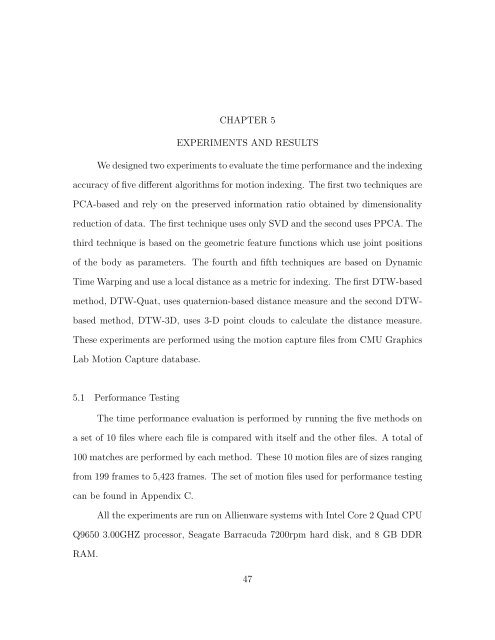A COMPARISON AND EVALUATION OF MOTION INDEXING ...
A COMPARISON AND EVALUATION OF MOTION INDEXING ...
A COMPARISON AND EVALUATION OF MOTION INDEXING ...
Create successful ePaper yourself
Turn your PDF publications into a flip-book with our unique Google optimized e-Paper software.
CHAPTER 5<br />
EXPERIMENTS <strong>AND</strong> RESULTS<br />
We designed two experiments to evaluate the time performance and the indexing<br />
accuracy of five different algorithms for motion indexing. The first two techniques are<br />
PCA-based and rely on the preserved information ratio obtained by dimensionality<br />
reduction of data. The first technique uses only SVD and the second uses PPCA. The<br />
third technique is based on the geometric feature functions which use joint positions<br />
of the body as parameters. The fourth and fifth techniques are based on Dynamic<br />
Time Warping and use a local distance as a metric for indexing. The first DTW-based<br />
method, DTW-Quat, uses quaternion-based distance measure and the second DTW-<br />
based method, DTW-3D, uses 3-D point clouds to calculate the distance measure.<br />
These experiments are performed using the motion capture files from CMU Graphics<br />
Lab Motion Capture database.<br />
5.1 Performance Testing<br />
The time performance evaluation is performed by running the five methods on<br />
a set of 10 files where each file is compared with itself and the other files. A total of<br />
100 matches are performed by each method. These 10 motion files are of sizes ranging<br />
from 199 frames to 5,423 frames. The set of motion files used for performance testing<br />
can be found in Appendix C.<br />
All the experiments are run on Allienware systems with Intel Core 2 Quad CPU<br />
Q9650 3.00GHZ processor, Seagate Barracuda 7200rpm hard disk, and 8 GB DDR<br />
RAM.<br />
47
















